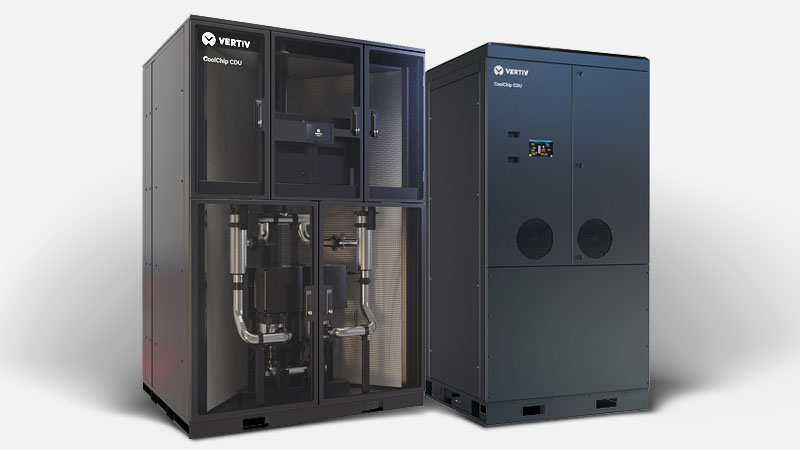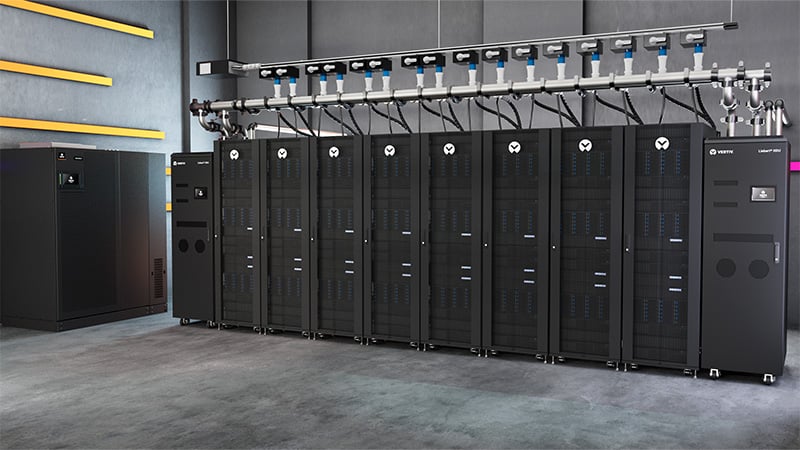The rapid advancement of artificial intelligence (AI) and machine learning (ML) drives an exponential increase in data processing demands, pushing data centers to their limits. High-performance computing (HPC) systems generate immense heat, while the rising density of chips, servers, and racks leads to higher power consumption and greater thermal output. Air-cooling methods alone become strained in keeping pace with these demands, creating a need for more efficient thermal management solutions.
This is where coolant distribution units (CDUs) come into play. CDUs offer a next-generation approach to managing heat and power consumption in data centers by integrating air and liquid cooling technologies. As businesses focus on boosting efficiency and reliability, CDUs are essential for maintaining optimal performance while addressing the growing heat challenges in modern data centers.

Vertiv™ AI Hub
Vertiv™ 360AI includes a complete portfolio of power, cooling and service solutions that solve the complex challenges arising from the AI revolution.
Adopting liquid cooling at existing data centers
The significance of liquid cooling is highlighted by its strong growth trajectory and increasing opportunities in the market. Liquid cooling is expected to extend beyond niche HPC applications, becoming more prevalent in mainstream cloud, colocation, and enterprise data centers.
Liquid cooling implementation strategies
The growth of the worldwide AI data center cooling market reflects the increased adoption of liquid cooling solutions. Direct-to-chip cooling is becoming the preferred method among these AI cooling deployments. While operators will build new facilities specifically for HPC workloads and liquid cooling, most implementations will occur in existing facilities.
Multi-tenant data center (MTDC) owners and operators strive to enhance their competitiveness, recognizing that offering HPC capabilities for AI and other workloads is gradually becoming an industry standard. Consequently, many are building a business case to introduce liquid cooling across racks and rooms, exploring various options, and developing a phased adoption roadmap.
What are coolant distribution units (CDUs)?

Vertiv™ CoolChip CDU is available in liquid-to-air configurations, operating by distributing fluid to the liquid-cooled IT equipment and rejecting that heat into the data center space through a liquid-to-air heat exchanger. The existing perimeter cooling equipment captures that heat and rejects it outside the white space.
Liquid cooling systems are gaining traction, but their successful implementation hinges on effective coolant control and distribution, and CDUs play a crucial role in this process.
CDUs deliver precisely controlled fluid to high-density IT equipment and remove excess heat from the system. By acting as a bridge between the facility's cooling infrastructure and the liquid-cooled servers, CDUs maintain optimal operating temperatures, prevent overheating, and enhance the overall efficiency of the cooling process. Without CDUs, liquid cooling's potential benefits—such as reduced energy consumption and improved cooling performance—cannot be fully realized.
Paths to adopting liquid cooling
There are many paths to adopting liquid cooling, and Vertiv has created a guide to assist you in selecting the right approach. One primary consideration is the type of CDU being deployed and the required infrastructure associated with it.

Create a roadmap for liquid cooling installation by downloading our guide
Liquid-to-liquid CDUs
Liquid-to-liquid CDUs, such as the Vertiv™ Liebert® XDU1350, must be connected to the facility's chilled water supply to remove heat from the liquid. This type of CDU uses a liquid-to-liquid heat exchanger to transfer heat from the IT equipment to the chilled water supply, which then rejects the heat outdoors. It supports liquid cooling in high-density environments, suitable for direct-to-chip and rear door cooling applications. This enables efficient support for higher rack densities and optimal system conditions, while offering easy and cost-effective deployment in any data center.
Liquid-to-air CDUs
When using liquid-to-air CDUs, such as the Vertiv Liebert XDU070, for direct-to-chip cooling applications, existing perimeter air-cooled units remain essential components of the thermal infrastructure. A secondary fluid network (SFN) running from the CDU to the racks is controlled by variable speed pumps to deliver optimal cooling capacity to support the liquid-cooled servers. The liquid-to-air heat exchanger then rejects the heat into the data center to be captured by the facility's current air-cooling configuration, seamlessly integrating with existing thermal management solutions.
This approach is ideal for a retrofit application where costly and time-consuming redesigns of the data center are not feasible or desired. By utilizing existing infrastructure, teams can also deploy a mix of liquid-cooled and air-cooled IT applications, providing a flexible, modular solution to future deployments and business needs. And although these units may be limited in cooling capacity when compared to their liquid-to-liquid counterparts, they don't require connection to the building's chilled water system, making them easier to install, potentially more space-efficient, and cost-effective compared to larger-scale liquid-to-liquid CDU deployments.
Choose your path to high-density
Combining air and liquid cooling technologies transforms AI data centers by addressing the intense heat loads associated with HPC workloads. With the increasing demand for processing power, more efficient cooling solutions are essential for maintaining optimal performance.
Take the next step towards high-density computing with confidence. No matter where you start or where you aim to go, Vertiv can customize solutions to transform your data center's cooling capabilities.





